Pollution as a Weapon of War
Author's introduction, 8 June 2023
Nine years of russian war of in Ukraine – that has accelerated and intensified since the full-scale invasion on 24 February 2022 – has been conducted primarily through the air, on the ground, and in cyberspace. The destruction, in a series of explosions on 6 June 2023 of the Nova Kakhovka Hydroelectric Power Plant in Kherson region controlled by the russian forces, marks a deadly turning point. Up to a hundred Ukrainian towns and villages, thousands of lives – human and non-human – as well as surrounding ecosystems are disappearing or are already lost under the floodwater. The Ukrainian evacuation effort is being blocked by russian forces, who keep shelling the territories after flooding them. Parts of the country are, quite literally, undergoing waterboarding – a method used by the russian forces on Ukrainian civilians in the torture chambers on the occupied territories and here scaled up to catastrophic effect. The following essay, part of the publication Climate: Our Right to Breathe (L’Internationale and K. Verlag, 2022) highlights the role of ecocide in contemporary wars. I am grateful to L’Internationale for the invitation to publish the text online in light of the shocking scenes unfolding in Ukraine.
L'Internationale would like to thank the author and K. Verlag for agreeing to publish this text on the online platform.

Kinder Album, Russia’s ecocide in Ukraine, 2023, 86 x 61 cm, watercolour.
Any war is an assault on the entire ecosystem in which all life- and non-life-forms interact, via nutrient cycles and energy flows within and beyond their immediate environments, in “geosomatic communities.” This makes their erasure by the war the crime of “geosomatocide,” as Ukrainian researcher Oleksii Kuchanskyi has described the unfolding catastrophe in Ukraine.1 Each war is different in how it disturbs and demolishes the assemblages of symbiotic co-existence. But there are similarities, too, and these are crucial to consider when trying to understand the environmental damage involved. Due to lack of data and situational changes too rapid to grasp, the nature of knowledge in wars, including knowledge about pollution, is often partial. When military action is ongoing, it is often not possible to acquire the necessary data to assess the impact of a war on the environment; in other cases, the data acquired is too tactically sensitive to publicize or share between institutions, organizations, and the public.
In order to envision the humanitarian and environmental consequences of the eight years of warfare waged in Ukraine by the Russian Federation that will have to be dealt with in the future, while data is scarce we can turn to what was learned during the wars in Syria and Iraq, as well as to pre-conflict data.2 At the time of writing (midsummer 2022), it is already possible to distinguish two phases in the spread of war-related pollution in Ukraine; these differ in terms of speed and volume. Phase one dates from 2014, with the illegal annexation of Crimea and the subsequent military action in the regions of Luhansk and Donetsk. Phase two began with the full-scale invasion of Ukraine on 24 February 2022, after which the spread and volume of pollution — with both short - and long-term impacts — greatly and dramatically accelerated and increased.
The partial nature of knowledge about pollution during wars lends itself to the possibility of pollution itself being weaponized, turning it, literally, into a weapon of war; and this tendency is also present in the Russian war in Ukraine. “Pollution as a weapon of war”: the formulation invokes rape, another well-known form of wartime violence and terror, to highlight the ferocity of this interference in urban and rural ecosystems; agricultural land, and rivers; coastal areas, and the sea; biospheric reserves, and other unique natural environments; that adds ecological crimes to a long list of war atrocities.
The weaponization of pollution during the Russian war in Ukraine has been happening in at least in two ways: First, there is the release of hazardous chemicals and the subsequent formation of dangerous chemical compounds such as carbon monoxide (CO), carbon dioxide (CO2), water vapor (H2O), nitric oxide (NO), nitrous oxide (N2O), nitrogen dioxide (NO2), formaldehyde (CH2O), cyanic acid vapors (HCN), nitrogen (N2), and water vapor (H2O),3 along with large amounts of toxic organic matter, both during direct combat and, more typically, in this war, during shelling. Targeting the civilian population and the military alike, these chemical compounds also damage life and non-life assemblages at large, causing the oxidization of soil, wood, and turf: just one of many forms of ecocide.
Another way the weaponization of pollution has occurred is at the level of misinformation and its communication in the media sphere: reframing, distorting, and instrumentalizing reported incidents, either with the purpose of inducing fear and panic in order to weaken the population’s potential to resist the occupying forces, or to engineer inadequate, and so dangerous, responses (to the release of chemicals, for example).
The attack on Ukraine and its more-than-human environment—exceeding in all dimensions the territorial horizontality that is often predominant in one’s imagination when one thinks of a war—was launched by land, sea, and air. At dawn on 24 February 2022, the eight years of warfare waged by the Russian Federation in Ukraine escalated to erupt into a full-scale invasion, the first major land war in Europe in decades. Following heavy shelling and airstrikes, the main infantry and tank attacks spearheaded four incursions to create a northern front that spread towards Kyiv, the capital of Ukraine, encircling the city from the north-east and east. Although the Russian troops crossed the Ukrainian border in several waves and from several directions, north, east, and south, it was the movement of this northern front through the Chernobyl Exclusion Zone that brought the Russian Federation its first impressive achievement—the fast and easy occupation of the Chernobyl Nuclear Power Plant (ChNPP). Aware of the consequences of a confrontation there, the Ukrainian military on the premises did not engage in combat. In addition to the threat to lives there at the hands of the invaders during the occupation of the ChNPP, the reckless actions of the Russian military in the Zone threatened both local and global communities.
While some Ukrainian officials described the takeover of the ChNPP as “absolutely senseless,”4 this event generated an overwhelming number of responses and interpretations in the news, on social media, and in public debates, evidencing its undeniable potential to impose terror. The takeover of the ChNPP, followed by its disconnection from the internationally accessible automated radiation monitoring system (ARMS), revealed a core nexus of the current cyberwar (a militarized assemblage of digital and kinetic actions, wherein commercial and military technologies are mobilized simultaneously for murder and destruction),5 when AI (such as those of the Norwegian Radiation and Nuclear Safety Authority (DSA)) pre-emptively envisioned a hypothetical accident in relation to the meteorological prognosis for winds and rain,6 modeling the potential dissemination of deadly nuclear fallout should the Chernobyl NPP’s New Safe Confinement (covering the insides of the decomposed Fourth Block) be suddenly hit by a rocket. The occupation of the ChNPP was followed by the subsequent takeover, on 3 March 2022, of the Zaporizhzhia Nuclear Power Plant in the south-east of Ukraine; the largest in Europe, with six active reactors. Thus materialized the possibility of a nuclear catastrophe: weaponizing the infrastructure of a nuclear power plant would turn it into a bomb with the capability to trigger a planetary-scale environmental disaster, resulting in the partial or full erasure of numerous geosomatic communities.
In the eyes of the world, the nuclear edge of the Russian war in Ukraine often appears to obscure numerous other forms of damage caused by pollution to the socio-material assemblages of geosomatic communities, including to the layers of soil and what rests and moves within and beneath them. According to Ukrainian scientists, the environmental damage caused by this war will result in biodiversity loss, and already constitutes a serious threat to endangered species. Chemical pollution from shelling and missiles impacts land and sea. Serious consequences have already accrued as a result of fires at industrial sites as well as forest fires, including those arising every spring and summer within the Chernobyl Zone, whose containment this year was made impossible by and during the ChNPP’s occupation by Russian forces and remains limited at the time of writing, three-and-a-half months since the Russian forces withdrew from the area, due to the landmining of surrounding territories. The demining process is ongoing. Fires caused by bombs and direct airstrikes have also been recorded at oil and fuel storage depots, gas stations, landfill sites, and low-level radioactive waste facilities like those targeted near Kyiv and Kharkiv.
The flooding of mines and the subsequent dissemination of toxic chemicals carried by groundwater was already a problem before the full-scale invasion, existing since the beginning of the war in 2014, when mines in the occupied territories were abandoned after the interruption of regular production processes in the Donbas area, and the water was no longer pumped out of them. As this toxic flood water spreads to large surface areas, it leads to soil collapse.7 This process has been greatly accelerated by the onset of intense military action in the south-east of Ukraine, including bombing and rocket strikes. At the time of writing this is still ongoing. The presence in the soil of heavy metals from the abandoned remnants of military weapons will cause significant long-term damage to the ecosystems of various regions of Ukraine.
Because it is now impossible for Ukrainian and international ecologists and other experts to conduct fieldwork in order to assess the scope of the pollution and design future strategies to deal with the environmental damage, they are remotely estimating the volume of emissions from the detonation of high-explosive munitions (either on the surface of the earth, or slightly submerged in it) using satellite images and studying what open-source environmental data they can find. They cross-examine footage uploaded to social media, public satellite imagery, and various optical and pollution-level sensor data that changes daily, geolocating and verifying the open-source information against the location of industrial facilities. All of these forms of data are then combined.
In one such instance, a satellite image produced by Maxar Technologies at the end of May 2022 was analyzed by the Ukrainian Nature Conservation Group (UNCG). The image captures the Izyum district of the Kharkiv region, where heavy military action was (and, at the time of writing, still is) ongoing. Noting that “even without appropriate qualifications, it can be assumed that the use of such a field after the war will be difficult and dangerous,” their experts “counted 480 funnel-shaped holes made by 82 mm caliber shells, 547 made by 120 mm shells and 1025 made by 152 mm caliber shells. Only (!) 50 tons of iron, 1 ton of sulfur compounds and 2.35 tons of copper entered the soil in this square kilometer of the field.” These explosions, the UNCG experts concluded, “uprooted at least 90,000 tons of soil.” This ecosystem is already severely damaged and will require a long time to recover, provided it doesn’t suffer irreversible erosion after the upper level of soil loses its fertility, releasing the organic matter into the atmosphere.8 What remains invisible, though, and thus unavailable for evaluation, is the reportedly rather high number of undetonated shells that are stuck in the soil, an estimated 3 to 30 percent of those that are there. These constitute a delayed form of damage, a fold in the complex temporality of the ecocidal trauma of war in Ukraine.
In tactical and strategic terms, the violent assault on the urban areas of Ukraine by the Russian forces is not anything novel. The bombing of Iraq by a combined force of troops from the United States and Great Britain, or that of Syria by Syrian and Russian forces, immediately come to mind. Various news reports and experts acknowledge Syria as the most recent military campaign to have served to contribute to Russian tactics and strategies.9 What they did in Syria, they have repeated in Ukraine: the besiegement of cities, to starve them into submission under ongoing shelling; the attacks on civilian targets; the bombing of refugee exit routes. The brutality of the Russian forces’ onslaught against Mariupol is often compared to that of their bombing campaign in Aleppo, when “massacring Aleppo’s civilians [was] part of a calculated strategy, aimed beyond this one city.”10
The significant use of heavy explosive weapons in residential areas quickly reduces settlements to rubble. In the course of the breakage of construction materials, large amounts of dust containing particles of asbestos, titanium, and different heavy metals are released into the air, that, when inhaled, cause such diseases as asbestosis, or scarring of the lungs; and mesothelioma, a type of lung cancer. Damage to heating and water supply facilities, such as sewage pumping stations, filter stations, water pumps, and other public utilities, leads to the contamination of water with organic substances.11
This war has engaged some of the most complex and diverse technological assemblages seen thus far—ranging from techniques and technologies of psyops and old-fashioned propaganda to those of extensive drone warfare, Starlink satellites, artificial intelligence, long- and short-range rocket systems, and, as of June 2022, the M142 High Mobility Artillery Rocket System (HIMARS), a lighter, wheeled, multiple-launch rocket system—and yet it has been frequently referred to as “medieval.” This perception is mainly due to the overall brutality of this war, and partially also to the consistent weaponization of human bodies after death. As reports and witness accounts reveal,12 all of Mariupol was covered with the bodies of those killed, and the minimal time between intervals of shelling did not allow for proper burials. People had to put the bodies in the ground everywhere in the city very close to the ground surface, as they were unable to dig deeper graves. Here, the presence of decomposing bodies creates an ideal environment for anaerobic bacteria and the accumulation of botulinum toxins that can migrate with ground- and rain-water, getting into water intake systems, or by being carried away by animals, to name just a few ways. These bacteria and toxins might well be described as the oldest biological weapon to have been used against humans during wars, and they remain very dangerous to us today. This is especially the case for the wounded, for whom contact with such bacteria carries a serious risk of developing life-threatening gangrene or tetanus (a bacterial infection caused by Clostridium tetani, largely characterized by muscle spasms).
In scholarship, pollution has been described as a form of “slow violence.”13 Writing about the “gradual velocity of slow violence,”14 British environmental and political geographer Thom Davies describes the violence of environmental pollution using the conceptual framework of “necropolitics” theorized by Cameroonian historian and political theorist Achille Mbembe, who put forward:
the notion of necropolitics, or necropower, to account for the various ways in which, in our contemporary world, weapons are deployed in the interest of maximally destroying persons and creating death-worlds, that is, new and unique forms of social existence in which vast populations are subjected to living conditions that confer upon them the status of the living dead.15
In war, however, pollution spreads—and violence occurs—at various speeds. In addition to the fast, or extremely fast, violence of the rocket strikes, bombs, and various explosions that cause immediate harm and destruction and lead to the release of toxic chemicals, there are also these other, slower forms of violence occurring “gradually and out of sight,”16 whether independently or as a consequence of these faster forms. Understandably, it is their slow and subtle nature that often renders them unnoticeable, elusive to human attention. Paradoxically, extreme cases of fast violence in war may also be made “invisible,” but by their overwhelming number and their capacity to produce shock and trauma: witnesses of war and war crimes often report that their memories collapse days of violence into one undifferentiated continuity. Together, cases of fast and slow violence compose the chaotic reality of war, whose production of necropolitical “death-worlds” does not lend itself to easy comprehension.17
Thus, theorizing pollution as a weapon of war entails not only accounting for the “drawn-out temporal reach” that the notion of slow violence opens up for critical thought,18 nor only recognizing the paradoxical invisibility of fast violence and its terror; but also understanding how the entanglement of these two regimes of violence, fast and slow, allows for the exploitation of international law so that, too often, environmental war crimes go unpunished.
The views and opinions published here mirror the principles of academic freedom and do not necessarily reflect the views or positions of the L'Internationale confederation and its members.
Related activities
Climate Forum
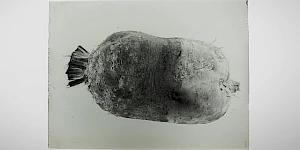
The Climate Forum is a space of dialogue with respect to the concrete eco-political operational practices implemented within the art field.
The Climate Forum is a space of dialogue and exchange with respect to the concrete operational practices being implemented within the art field in response to climate change and ecological degradation. This is the first in a series of meetings hosted by HDK-Valand within L'Internationale's Museum of the Commons programme.
The series builds upon earlier research resulting in the (2022) book Climate: Our Right to Breathe and reaches toward emerging change practices. It asks: How might the speculative and critical insights framed within the registers of the discursive, the affective, and the symbolic be operationalised within everyday working? While the wider agenda of the series is to consider institutional practices, the first session maps some of the ways ecopolitics are formulated by artist and activist iniatives.
Register here.
The Soils Project
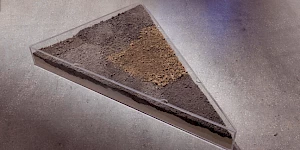
The Soils Project, is part of the eponymous, long term research initiative involving Tarrawara Museum of Art, Wurundjeri Country, Australia, the Van Abbemuseum in Eindhoven, Netherlands and Struggles for Sovereignty, a collective based in Yogyakarta, Indonesia. It works through specific and situated practices that consider soil, as both metaphor and matter. A further iteration of the project will open at the Van Abbemuseum in May - September 2024 as part of Museum of the Commons.
The Soils Project has been in development since 2018. An international collaboration between three organisations, and several artists, curators, writers and activists, the project has manifested in various iterations over several years including a three-part public webinar series titled The Soils Project: groundwork, and a two-week workshop, titled The Soils Project: On Country, for participating curators and artists. With a curatorium comprising arts workers from TarraWarra Museum of Art, the Van Abbemuseum, and Struggles for Sovereignty, the project’s approach seeks and facilitates opportunities to listen to diverse voices and perspectives around notions of caring for land, soil and sovereign territories.
Developed from this journey, The Soils Project’s forthcoming exhibition will embrace the deep histories of each participant’s location, examining the multiplicity of landscapes and environments, and the impact of colonisations and global industries on cultural heritage, land management and traditional knowledges.
Non-Western Technologies for the Good Life
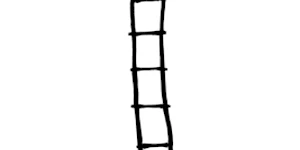
The experimental course 'Non-Western Technologies for the Good Life' (November 2023 – May 2024) celebrates as its starting point the anniversary of 50 years since the publication of Tools for Conviviality, considering that Ivan Illich’s call is as relevant as ever.
Summer School: Our Many Easts
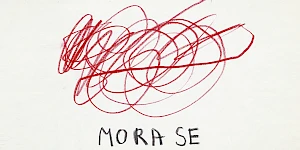
Our Many Easts summer school is organised by Moderna galerija in Ljubljana in partnership with ZRC SAZU (the Research Centre of the Slovenian Academy of Sciences and Arts) as part of the L’Internationale project Museum of the Commons.
Open Call – Summer School: Our Many Easts

Our Many Easts summer school takes place in Ljubljana 24–30 August and the application deadline is 15 March. Courses will be held in English and cover topics such as the legacy of the Eastern European avant-gardes, archives as tools of emancipation, the new “non-aligned” networks, art in times of conflict and war, ecology and the environment.
Gathering into the Maelstrom
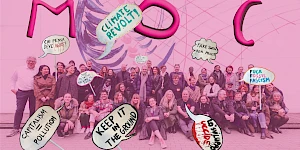
Gathering into the Maelstrom in Venice at Sale Docks is a four-day programme curated by Institute of Radical Imagination (IRI) and Sale Docks.
Related contributions

Decolonial aesthesis: weaving each other
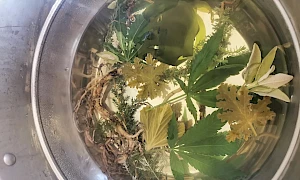
Climate Forum Readings
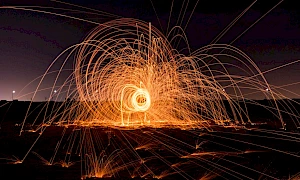
…and the Earth along. Tales about the making, remaking and unmaking of the world.
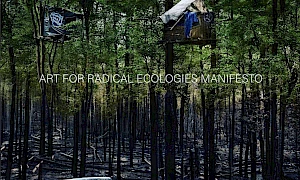
Art for Radical Ecologies Manifesto
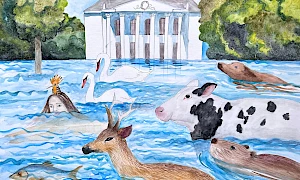
Pollution as a Weapon of War
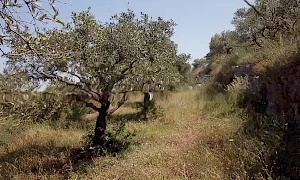
A Letter Inside a Letter: How Labor Appears and Disappears
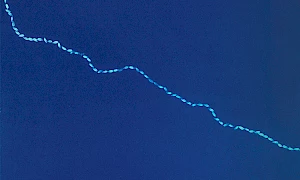
Seeds Shall Set Us Free II
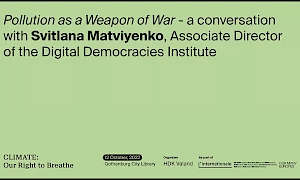
Pollution as a Weapon of War – a conversation with Svitlana Matviyenko
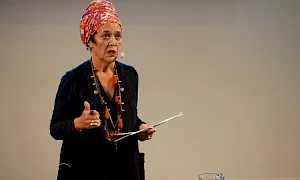
Françoise Vergès – Breathing: A Revolutionary Act
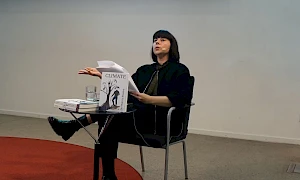
Ana Teixeira Pinto – Fire and Fuel: Energy and Chronopolitical Allegory
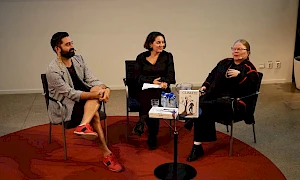
Watery Histories – a conversation between artists Katarina Pirak Sikku and Léuli Eshrāghi
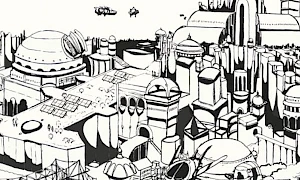
Indra's Web
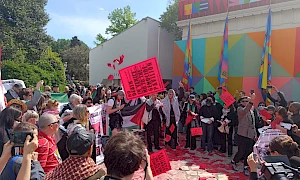
One Day, Freedom Will Be
